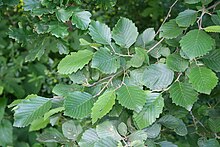Gray wooden owl
| Gray wooden owl | ||||||||||||
|---|---|---|---|---|---|---|---|---|---|---|---|---|

Gray wooden owl ( Lithophane consocia ) |
||||||||||||
| Systematics | ||||||||||||
|
||||||||||||
| Scientific name | ||||||||||||
| Lithophane consocia | ||||||||||||
| ( Borkhausen , 1792) |
The gray wooden owl ( Lithophane consocia ) is a butterfly ( moth ) from the family of the owl butterflies (Noctuidae).
features
butterfly
The wingspan of the moth is 43 to 48 millimeters. The color of the forewing upper side varies from slate gray to dark gray. At the base of the wing, a whitish to yellowish field starting at the front edge stands out , which is bordered in the middle by a black root welt. Ring and tenon flaws are colored light gray. The kidney defect is usually filled with reddish brown. The black-brown wavy line is laid out whitish. The upper side of the hind wing is gray-brown without drawing, the fringes are gray-white. The proboscis is well developed.
Caterpillar and pupa
Young caterpillars are green and show whitish longitudinal stripes, when fully grown they take on a gray-brown to gray-yellow color. The back, side back and side lines are then colored yellow or brick red and interrupted in black. The point warts are yellowish and blackish lined, the head is black-brown and yellow dotted. The doll shows a two-pointed cremaster on which there are some bristles. It rests in a web in the earth or between leaves of the food plant.
Similar species
- The brown-gray wooden owl ( Lithophane furcifera ) is generally darker and less contrasting in its overall appearance.
- In the Gagelstrauch-Moor-Holzule ( Lithophane lamda ) the black root welt is bent L-shaped.
distribution and habitat
The gray wood owl occurs locally in northern and central Europe. In Siberia , Japan and Korea that is a subspecies Lithophanes consocia grisea ( Grasses , 1889) at home. The species occurs in open tundra and taiga areas as well as in shrubby terrain, montane stream valleys, swampy forests and in the hill country.
Way of life
The moths fly in one generation from September to November, overwinter and then live from March to May of the following year. They are nocturnal and visit artificial light sources and bait . They were also observed drinking tree sap or sucking on flowers. The caterpillars live mostly from May to July. In Finland they feed exclusively, in the rest of Fennoscandinavia mainly on the leaves of the gray alder ( Alnus incana ). Sometimes other types of alder ( Alnus ) or hazelnut ( Corylus ) are also accepted as food.
Individual evidence
- ↑ a b c László Ronkay, José Luis Yela, Márton Hreblay: Hadeninae II. - Noctuidae Europaeae, Volume 5. , Sorø, 2001, ISBN 87-89430-06-9 , pp. 138/139
- ↑ Walter Forster , Theodor A. Wohlfahrt : The butterflies of Central Europe. Volume 4: Owls. (Noctuidae). Franckh'sche Verlagshandlung, Stuttgart 1971, ISBN 3-440-03752-5 , S 193/194
- ↑ Günter Ebert (Ed.): The butterflies of Baden-Württemberg Volume 6, Nachtfalter IV. Ulmer Verlag Stuttgart 1997 (Eulen (Noctuidae) 2nd part), ISBN 3-8001-3482-9 , pp. 517-520
literature
- Günter Ebert (Hrsg.): The Butterflies of Baden-Württemberg Volume 6, Nachtfalter IV. Ulmer Verlag Stuttgart 1997 (Eulen (Noctuidae) 2nd part), ISBN 3-8001-3482-9
- László Ronkay, José Luis Yela, Márton Hreblay: Hadeninae II. - Noctuidae Europaeae, Volume 5. , Sorø, 2001, ISBN 87-89430-06-9
Web links
- Lepiforum eV - taxonomy and photos
- funet.fi - dissemination
- insecta.pro - Lithophane consocia at Insecta Pro

